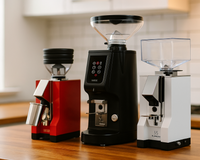The Search for the Best Espresso Beans: Single Origin vs Blends
When it comes to brewing the perfect cup of espresso, choosing the right beans is key. But with so many options on the market, it can be tough to decide what type of beans to choose. Two of the most popular options are single origin beans and blends. While both have their advantages, the debate of which is the best for espresso has been ongoing for years. In this blog post, we will dive into the pros and cons of each type of bean, so you can make an informed decision and find the best espresso beans for your taste buds.

What are Single Origin Beans?
Defining Single Origin Beans
Single origin coffee beans are coffee beans that come from a single geographic location, usually a single farm or a small group of farms in the same region. They are prized for their unique flavor characteristics, which are influenced by factors such as the type of soil, altitude, and climate of the region where they are grown. Single origin coffee is often considered to be higher quality than blended coffee, as it allows the flavors of the coffee beans to shine through.

Image courtesy of Climate.gov
Advantages of Single Origin Beans
🟢 Unique Flavor Profile
Single origin coffee beans come from a specific region or country, and they have a unique flavor profile that is determined by the region's soil, climate and altitude. This allows coffee drinkers to experience a wide range of flavors, from nutty and chocolatey to fruity and floral.
🟢 Traceability
Single origin beans are often traceable back to the exact farm or estate where they were grown. This allows coffee drinkers to learn more about the origin of their coffee and the people who grew it.
🟢 Support for Small-Scale Farmers
Single origin beans often come from smaller farms, and by purchasing single origin beans, coffee drinkers can support small-scale farmers and their communities.
🟢 Environmental Sustainability
Single origin coffee beans are often grown using environmentally sustainable methods, and purchasing single origin coffee can help support environmentally friendly farming practices.
🟢 Quality Control
Single origin coffee is often carefully monitored and controlled, and the beans are hand-picked to ensure that only the highest quality beans are used.
Overall, single origin coffee beans offer a unique and memorable coffee drinking experience, and they can be a great way to support sustainable and responsible coffee farming practices.
Disadvantages of Single Origin Beans
🔴 Availability
Single origin coffee beans can be difficult to find, especially if they come from a small, remote region. Additionally, the supply of single origin beans can be limited, so coffee drinkers may have to search for their preferred single origin beans.
🔴 Cost
Single origin coffee beans can be more expensive than blends, as the beans are sourced from a specific region and the cost of production can be higher.
🔴 Inconsistent Flavor
Because single origin coffee beans come from a specific region, the flavor profile of the beans can vary greatly depending on the season, weather and other factors. This can lead to an inconsistent taste in the coffee, and it can be difficult to replicate the same flavor profile from one cup to the next.
🔴 Lack of Balance
Single origin coffee beans can sometimes have strong and overpowering flavors, which can make for a less balanced and enjoyable coffee drinking experience.
🔴 Limited Options
With single origin coffee beans, coffee drinkers are limited to the flavors and profiles of the beans from a specific region. This can be a disadvantage for coffee drinkers who are looking for a wider range of flavor options.
What are Espresso Blends?
Espresso blends are mixtures of coffee beans from different origins that are blended together to create a unique flavor profile specifically for espresso drinks. These blends are carefully crafted to produce a consistent flavor and balance of acidity, sweetness, and bitterness, which is ideal for the short, intense extraction process used to make espresso. The beans used in espresso blends are typically roasted to a medium to dark roast, which brings out rich, full-bodied flavors and adds to the overall character of the espresso. Espresso blends are often designed to work well with milk-based drinks like lattes and cappuccinos, and may be adjusted seasonally to take into account changes in the coffee market.
Composition of Espresso Blends
Espresso blends typically consist of a combination of coffee beans from different origins that are chosen for their complementary flavor profiles. The composition of an espresso blend may vary depending on the roaster or brand, but typically includes beans from one or more of the following regions:
-
South America: Known for producing coffee with a balanced acidity and mild sweetness, beans from this region are often used as a base in espresso blends.
-
Africa: African coffee beans are known for their bright, fruity acidity and wine-like flavors, which can add complexity to an espresso blend.
-
Asia: Coffee beans from this region tend to be more full-bodied and have earthy, spicy notes. They are often used to add depth and richness to an espresso blend.
-
Central America: Beans from this region are known for their mild, nutty flavors and gentle acidity, which can provide balance to an espresso blend.
The specific composition of an espresso blend will depend on the desired flavor profile, with some blends designed to be brighter and more acidic, while others are crafted to be richer and more full-bodied. The roaster may adjust the blend over time, taking into account changes in coffee availability and quality from different regions.
Advantages of Espresso Blends
🟢 Consistency
Espresso blends are carefully crafted by coffee roasters to create a consistent flavor profile. This allows coffee drinkers to enjoy the same rich and balanced flavor in every cup of espresso, regardless of the origin of the beans.
🟢 Balancing Flavor
Espresso blends are made up of different types of coffee beans with different flavor profiles, and the exact composition of the blend can vary from roast to roast. By blending, coffee roasters aim to produce a balanced flavor that is smooth and enjoyable.
🟢 Wide Availability
Espresso blends are widely available in coffee shops and grocery stores, making them easy to find and purchase.
🟢 Affordable
Espresso blends are often more affordable than single origin coffee beans, making them a more budget-friendly option for coffee drinkers.
🟢 Versatility
Espresso blends are designed to be used in a variety of espresso-based drinks, from lattes and cappuccinos to Americanos and macchiatos. This makes them a versatile option for coffee drinkers who enjoy a variety of espresso-based drinks.
Overall, espresso blends are a popular choice for coffee drinkers who are looking for a consistent and balanced flavor in their espresso, and who value the convenience and affordability of a widely available option.
Disadvantages of Espresso Blends
🔴 Lack of Unique Flavor
Espresso blends are designed to have a consistent flavor profile, which can result in a lack of unique or memorable flavors. For coffee drinkers who are looking for a truly distinctive taste experience, single origin coffee beans may be a better option.
🔴 Poor Quality Beans
Not all espresso blends are created equal, and some blends may contain lower quality coffee beans. This can result in a subpar flavor and texture in the espresso.
🔴 Blending Process
The blending process can sometimes mask the individual characteristics of the coffee beans, which can result in a homogenized and less interesting flavor profile.
🔴 Limited Options
With espresso blends, coffee drinkers are limited to the specific flavor profiles that are created by the roaster. This can be a disadvantage for coffee drinkers who are looking for a wider range of flavor options.
🔴 Lack of Transparency
It can be difficult to know exactly what goes into an espresso blend, as the composition of the blend can vary from roast to roast. This lack of transparency can make it challenging for coffee drinkers to make an informed decision about the quality and origin of the beans they are purchasing.
Overall, while there are some disadvantages to using espresso blends, many coffee drinkers find that the consistent flavor profile and affordability of espresso blends make them a desirable option.
Which is the Best Option for Espresso?
The best type of bean for making espresso is subjective and depends on personal preference.
Single origin coffee beans are known for their unique and distinctive flavor profiles, which can be influenced by factors such as the origin, climate, altitude, and processing method. This can make for a truly memorable espresso experience for coffee drinkers who appreciate a distinctive and flavorful cup.
On the other hand, espresso blends are designed to produce a consistent and balanced flavor profile in every cup. The blending process allows coffee roasters to create a smooth and enjoyable flavor by combining different types of coffee beans with different flavor profiles. This can make espresso blends a popular choice for coffee drinkers who value consistency and a balanced flavor in their espresso.
Ultimately, the choice between single origin coffee beans and espresso blends is a matter of personal preference and what you value most in your coffee. Some coffee drinkers prefer the unique and memorable flavor of single origin coffee beans, while others prefer the consistency and balance of espresso blends.
Can Coffee be Compared to Wine?
Yes, coffee can be compared to wine in several ways. Both coffee and wine are complex beverages with a wide range of flavor profiles, aromas, and textures that can be influenced by factors such as origin, processing methods, and growing conditions.
Just like wine, coffee can be evaluated and appreciated for its unique flavor characteristics, and connoisseurs of coffee often have a deep appreciation for the differences between various types of coffee beans and roasts.
Additionally, both coffee and wine have a rich cultural history and tradition, and both can be enjoyed in a variety of settings and occasions. Whether it's a casual cup of coffee in the morning or a wine tasting event, both coffee and wine have a special place in many people's lives.
Overall, while coffee and wine are not exactly the same, there are many similarities between the two beverages that make it possible to compare and appreciate them in similar ways.
What to Consider When Buying Coffee
Type of Bean
Decide whether you want to buy whole bean coffee or pre-ground coffee, and what type of bean you prefer such as Arabica or Robusta.
Roast Level
Choose the roast level that best fits your taste preferences, such as light, medium, or dark roast.
Origin
Consider the origin of the coffee beans, as different regions produce beans with different flavor profiles.
Flavor Profile
Read the flavor profile of the coffee, as it can provide information about the type of taste to expect.
Brand Reputation
Research the brand and look for reviews from other coffee drinkers to gauge the quality of the coffee.
Certification
Consider looking for coffee that is certified organic, Fair Trade, or Rainforest Alliance, as these certifications indicate ethical and sustainable sourcing practices.
Price
Determine your budget and compare prices, keeping in mind that quality coffee can come at a higher price.
Grinding
If purchasing whole bean coffee, consider the type of grind you'll need for your brewing method.
Freshness
Ensure that the coffee is freshly roasted, as coffee begins to lose its flavor soon after roasting. If it was roasted over 30 days ago, put it back. If the bag doesn't even have a roast date listed on it, put it back.
What About a Subscription Service?
What is a coffee subscription?
A coffee subscription is a service where customers can receive regular deliveries of coffee beans or ground coffee from a specific roaster or coffee company. Customers can sign up for a coffee subscription and choose their preferred coffee blends, frequency of delivery, and grind type. The coffee is then delivered directly to their door on a regular basis, ensuring that they always have fresh, high-quality coffee on hand.
Coffee subscriptions are popular with coffee lovers who want to discover new and unique coffee blends, or those who simply want the convenience of having fresh coffee delivered regularly to their door. Some coffee subscriptions also offer additional benefits, such as exclusive access to limited edition blends, special promotions, and discounts on other coffee-related products.
Overall, a coffee subscription can be a great way to explore new coffee blends, ensure a steady supply of fresh coffee, and even save money in the long run.
Our Favorite Subscription Service: Blue Bottle Coffee
















